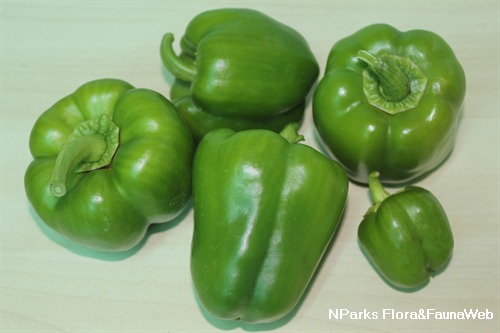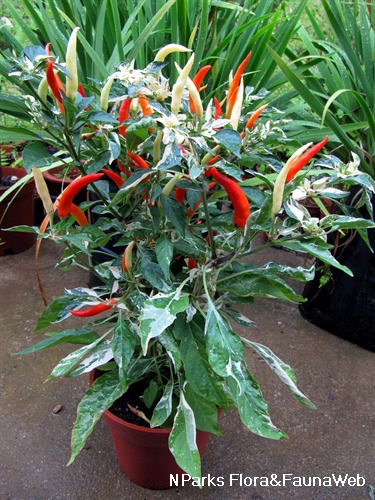-pauline-tay-(1).jpg)
Back
Capsicum annuum (red bell pepper)
| Family Name: | Solanaceae |
| Common Name: | Capsicum, Bell Pepper, Cili Benggala, 灯笼椒 |
Name
Classifications and Characteristics
| Plant Division | Angiosperms (Flowering Seed Plants) (Dicotyledon) |
|---|---|
| Plant Growth Form | Shrub |
| Lifespan (in Singapore) | Annual |
| Mode of Nutrition | Autotrophic |
| Plant Shape | Shrubby |
| Maximum Height | 1.5 m |
Biogeography
| Native Habitat | Terrestrial (Agricultural Land) |
|---|---|
| Preferred Climate Zone | Tropical, Sub-Tropical / Monsoonal |
| Local Conservation Status | Non-native (Horticultural / Cultivated Only) |
Description and Ethnobotany
| Growth Form | Annual herb to semi-woody shrub that grows erect up to 1.5 m tall. |
|---|---|
| Foliage | Leaves are elliptical, alternately arranged along the stem, has entire margin and a pointy tip. |
| Flowers | White, star-shaped flowers hang downwards from the stem. They are composed of 5 triangular, slightly cupped petals. |
| Fruit | Shiny, smooth fruits are botanically classified as berries. The flesh is crisp and juicy with a mild flavour. The skin is initially medium green and later turns to red. The interior is mostly filled with air and a large number of cream-coloured, disk-shaped seeds. |
| Cultivation | Keeping the fruit longer on the plant before harvesting increases its sweetness and Vitamin C content. Seeds may take 7 to 10 days to germinate. Depending on the varieties, the plant may take 90 to 120 days to mature. Grow the plant in a sunny location with a stake for support as the fruit may be heavy for the plant. |
| Etymology | The genus epithet 'Capsicum' refers to the hot taste of the fruit. The specific epithet 'annuum' means annual, which refers to the plant growth cycle in a year. |
| Ethnobotanical Uses | Edible Plant Parts : Edible Fruits Food (Fruit or Vegetable): Red bell peppers are widely consumed raw or cooked as a vegetable. They are rich in vitamins A and C. Cooking the peppers at higher heat for longer periods of time may destroy some of their nutrient content. The green bell peppers sold in supermarkets are typically red bell peppers that were harvested before they could turn red. |
Landscaping Features
| Desirable Plant Features | Ornamental Fruits |
|---|---|
| Landscape Uses | Container Planting, Parks & Gardens, Small Gardens |
| Thematic Landscaping | Economic Garden |
Fauna, Pollination and Dispersal
| Fauna Pollination Dispersal Associated Fauna | Bird-Attracting (Fruits) |
|---|---|
| Pollination Method(s) | |
| Seed or Spore Dispersal |
Plant Care and Propagation
| Light Preference | Full Sun |
|---|---|
| Water Preference | Moderate Water |
| Plant Growth Rate | Moderate |
| Rootzone Tolerance | Easy to Grow, Fertile Loamy Soils, Moist Soils, Well-Drained Soils |
| Fertilizing | Apply fertilizer high in K (potassium) to induce flowering and fruiting once every 2 weeks. |
| Potential Problems | Aphids, mealybugs, whiteflies, thrips |
| Diseases | Root Rot caused by Phytophthora capsici. This disease appears when soil is excessively wet due to overhead irrigation or heavy rain. |
| Pest(s) | Sucking Insects |
| Propagation Method | Seed |
Foliar
| Foliage Retention | Evergreen |
|---|---|
| Mature Foliage Colour(s) | Green |
| Mature Foliage Texture(s) | Smooth |
| Prominent Young Flush Colour(s) | Green |
| Young Flush Texture(s) | Smooth |
| Foliar Type | Simple / Unifoliate |
| Foliar Arrangement Along Stem | Alternate |
| Foliar Attachment to Stem | Petiolate |
| Foliar Shape(s) | Non-Palm Foliage (Elliptical) |
| Foliar Venation | Pinnate / Net |
| Foliar Margin | Entire - Wavy / Undulate |
| Foliar Apex - Tip | Acuminate |
| Foliar Base | Cuneate |
Floral (Angiosperm)
| Flower & Plant Sexuality | Bisexual Flowers |
| Flower Colour(s) | White |
|---|---|
| Flower Texture(s) | Smooth |
| Flower Symmetry | Radial |
| Individual Flower Shape | Stellate / Star-shaped |
| Flowering Habit | Polycarpic |
Fruit, Seed and Spore
| Mature Fruit Colour(s) | Green |
|---|---|
| Mature Fruit Texture(s) | Smooth, Glossy / Shiny |
| Fruit Classification | Simple Fruit |
| Fruit Type | |
| Mature Seed Colour(s) | Cream / Off-White |
| Mature Seed Texture(s) | Smooth |
| Seed Quantity Per Fruit | Numerous (>20) |
Image Repository
Others
| Master ID | 32106 |
|---|---|
| Species ID | 6512 |
| Flora Disclaimer | The information in this website has been compiled from reliable sources, such as reference works on medicinal plants. It is not a substitute for medical advice or treatment and NParks does not purport to provide any medical advice. Readers should always consult his/her physician before using or consuming a plant for medicinal purposes. |

_pauline_tay-(2).jpg)




_kevin_tan.jpg)



